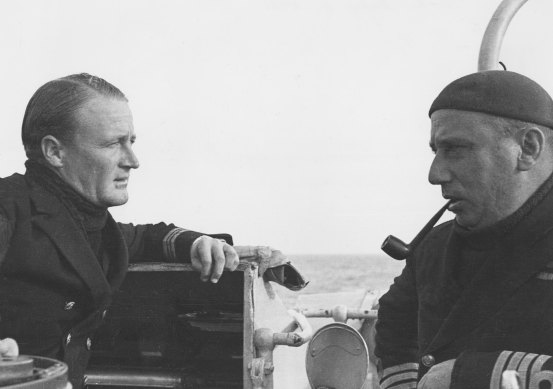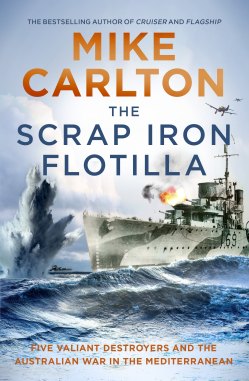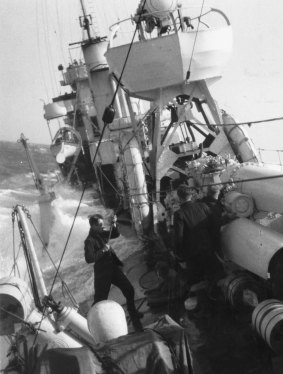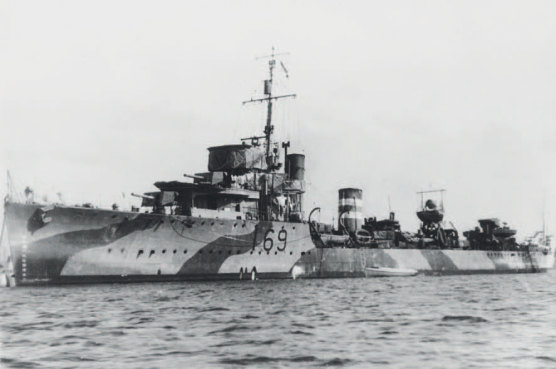By Pat Sheil
When Australians look in the rear-vision mirror of history to the Second World War, much of what we see are the horrors and heroics of the conflict in the Asia Pacific. This makes sense. Darwin, Broome, Kokoda, Borneo, Burma – after the fall of Singapore, Australia’s hopes and fears all lay to our immediate north.
But we had been at war with Germany for two years before any of that began, when Robert Menzies made the announcement on September 3 at 9.15pm, Sydney time, that, as a consequence of Britain declaring war on Germany after the invasion of Poland, “Australia is also at war”.

Lieutenant Commander Rodney Rhoades (left), captain of the Vendetta, with Hector “Hec” Waller, captain of the Stuart and overall commander of The Scrap Iron Flotilla.Credit: Royal Australian Navy
There was no debate about such things in 1939. Menzies was simply stating the obvious, and, while some urged caution, given what the Japanese were up to in Manchuria, there were few in Australia who disagreed with him. Less than an hour after Menzies’ broadcast, this British Admiralty telegram was forwarded to all Australian ships: “Commence Hostilities At Once With Germany.”
This is the point where Mike Carlton’s engrossing exploration of a little-known chapter in Australian naval history begins. In The Scrap Iron Flotilla, he recounts the remarkable voyages of five antiquated Australian destroyers that, within weeks of war being declared, set sail for the Mediterranean to take their places alongside the Royal Navy.
By the time they first encountered the enemy in 1940, HMAS Vendetta, Vampire, Voyager, Stuart and Waterhen were by no means state-of-the-art fighting machines. The youngest, Stuart, was being built in Britain while fighting still raged on the Western Front and was commissioned in December 1918, only weeks after the Armistice. The rest were of a similar vintage, with Vendetta, the oldest, having seen action in 1917.

Credit:
A little slower and more cantankerous than in their youth, the ships were still capable of more than 30 knots and well armed. They were forces to be reckoned with, and Carlton recounts their joint and various deployments in the eastern Mediterranean with a confidence born of thorough research, and a contagious affection for the ships and their crews.
The title comes from a long-standing British and Australian tradition of enthusiastically adopting the derision of enemy propaganda as badges of honour.
Veterans of the early battles of WWI proudly adopted the moniker “The Old Contemptibles” from the Kaiser’s description of them as a “contemptible little army”, and these Australian sailors happily took on board Joseph Goebbels’ description of their little fleet as a “a load of scrap iron”.
The first months of 1940 were quiet to the point of boredom until June 11, the day after Mussolini joined the Axis alliance and the Italians carried out the first of what was to become almost three years of relentless air raids on Malta. Vendetta, in port there that day, escaped harm, and three days later Voyager claimed first blood, depth charging an Italian submarine off Alexandria.

HMAS Vendetta in a heavy sea, with her gunnery officer secured by a lifeline.Credit: Royal Australian Navy
Carlton details the changing, and rapidly deteriorating, situation for the Allies in the Mediterranean as the war grinds on. France falls, taking its substantial navy out of the equation. German U-boats wreak havoc in the Atlantic, stretching the Royal Navy to the limit. Italy’s navy surface fleet was hesitant but still dangerous, and their submarines had laid countless mines, even before formally entering the war.
But the Italians became the lesser of two evils in 1941 when, after their army’s disastrous campaigns in Greece and Libya imploded, Hitler decided to take all matters Mediterranean into his own hands.
By the time Rommel’s Afrika Korps had pushed deep across the Libyan desert and Wilhelm List’s murderous 12th Army were pouring into Greece, the five destroyers found themselves under constant attack. Keeping the besieged Australians and British troops in Tobruk fed, watered and armed, as well as evacuating Australian and New Zealand forces from the debacles in Greece and Crete, was exhausting, harrowing work.
Given that they’d put to sea just after war had been declared, and the dire situations they’d found themselves in, it’s remarkable that three of the destroyers were still in tact in 1945.
Two were not so lucky. The Stuka dive bomber, with its terrifying howling sirens, was the instrument of destruction of the Waterhen, heavily damaged off the Libyan coast ferrying ammunition to Tobruk. The damage inflicted by only two of them made towing the crippled ship to safety impossible, and it went to the bottom on June 30, 1941, but without the loss of a single man. Voyager survived the Mediterranean, but was abandoned after grounding on the sands of Timor in 1942.

HMAS Vendetta in calmer waters.Credit: Royal Australian Navy
As well as detailing the complex and overlapping missions of the five ships, Carlton paints revealing portraits of some of the key players and succinct, often amusing thumbnail sketches of dozens of the sailors.
Foremost among them is Hector “Hec” Waller, captain of the Stuart, overall commander of the Scrap Iron Flotilla and, by April 1940, four Royal Navy destroyers. His feats of seamanship, leadership and equanimity under fire were tempered by an informal humanity that verged on the casual, a combination that engendered a fierce loyalty from his crews.
While the Stuart survived the war, Waller was killed commanding the doomed cruiser Perth during the disastrous Battle of The Java Sea on March 1, 1942.
The Scrap Iron Flotilla is the story of hundreds of tenacious, terrified, brave and battle-weary Australian sailors who had no idea whether they’d make it home. They were given a job to do, they did it, and Carlton does them proud.
The Scrap Iron Flotilla by Mike Carlton is published by William Heinemann, $34.99.
The Booklist is a weekly newsletter for book lovers from books editor Jason Steger. Get it delivered every Friday.